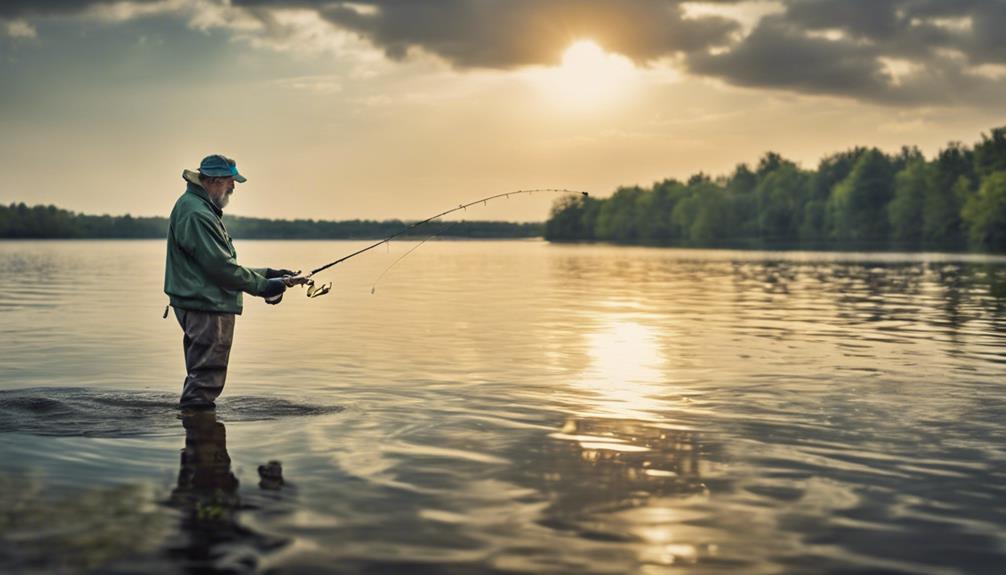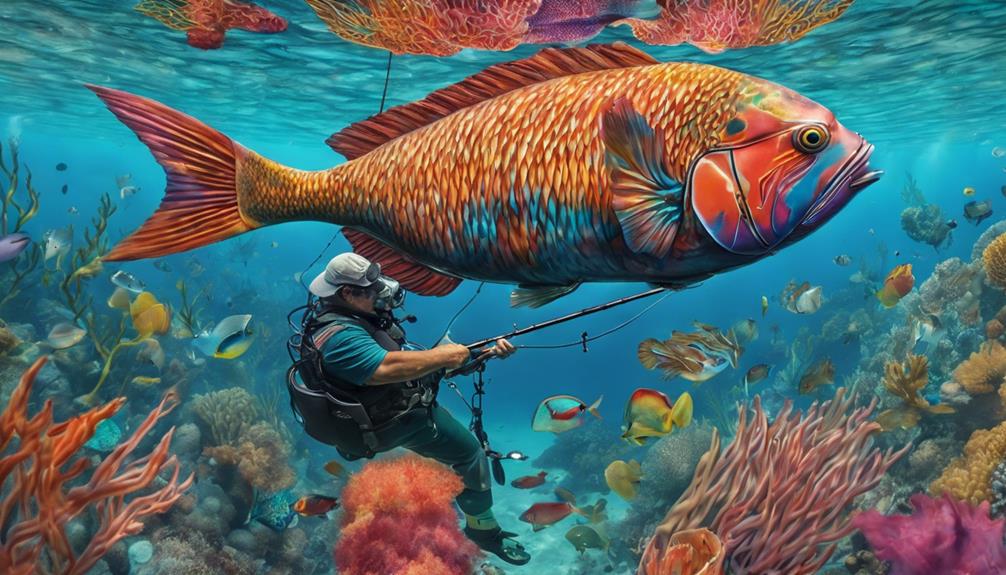When targeting bass, it's crucial to understand the habits and preferences of this elusive species to increase your chances of a successful catch.
But what about the other types of fish? Each species presents its own set of challenges and opportunities when it comes to fishing.
By mastering specific techniques tailored to each type of fish, you can significantly enhance your fishing game.
Stay tuned to discover the top 10 techniques that will help you reel in that prized catch, no matter the species.
Bass Fishing Techniques
When targeting bass, mastering the art of casting accurately is crucial for success in bass fishing. Whether you're after the elusive largemouth bass or the feisty smallmouth bass, understanding the right techniques is key to landing your catch.
For largemouth bass, topwater lures are highly effective. These lures mimic the movement of prey on the water's surface, enticing the bass to strike. When using topwater lures, focus on casting near structures like fallen trees, lily pads, or rocky outcrops where largemouth bass tend to hide. Make sure to reel in the lure with a steady retrieve to create enticing ripples and splashes that will attract the attention of these predatory fish.
On the other hand, smallmouth bass are known for their cunning nature and are often more easily spooked. To target smallmouth bass successfully, finesse techniques are essential. Using light tackle and subtle presentations like drop shots, Ned rigs, or wacky worms can yield great results. When casting for smallmouth bass, aim for rocky areas or drop-offs where they like to forage for food. Remember to use a slow, twitching retrieve to entice strikes from these cautious fish.
Trout Fishing Tips
To enhance your trout fishing success, mastering the art of presenting natural-looking bait is essential. Trout are known for their cautious nature, making it crucial to use techniques that mimic their natural prey. Here are some tips to help you improve your trout fishing game:
- Use Fly Fishing: Trout are often enticed by the delicate presentation of flies on the water's surface. Mastering the art of fly fishing can significantly increase your chances of catching these elusive fish.
- Employ Stream Tactics: Understanding how to read the water and identify where trout are likely to be hiding is key. Utilize stream tactics such as casting upstream and letting your bait drift naturally downstream for a more lifelike presentation.
- Match the Hatch: Pay attention to the insects hatching in the area and try to match your bait to what the trout are feeding on. This attention to detail can make a significant difference in enticing bites.
- Stay Stealthy: Trout have excellent vision and are easily spooked. Wear muted colors, approach the water quietly, and make gentle casts to avoid alerting the fish to your presence.
Salmon Fishing Strategies
Mastering effective salmon fishing strategies requires understanding the behavior and habitat preferences of these powerful fish. When it comes to fly fishing tactics for salmon, it's crucial to match the hatch by using flies that mimic the insects or baitfish present in the water. Additionally, understanding river navigation is key to locating prime spots where salmon are likely to gather, such as deep pools, eddies, or near submerged structures where they can rest.
Trolling techniques are also popular for salmon fishing, especially in larger bodies of water. When trolling for salmon, consider varying your trolling speed to find the optimum pace that entices these fish to strike. Experiment with different lures and colors to determine what the salmon are actively feeding on in that particular environment. Bait selection is crucial; using fresh bait like herring, anchovies, or even artificial lures can attract salmon effectively.
Remember to pay attention to the depth at which salmon are feeding and adjust your bait or lure accordingly. By mastering these fly fishing and trolling techniques, along with making informed decisions about bait selection, you can increase your chances of a successful salmon fishing expedition. Happy fishing!
Crappie Fishing Tricks
Understanding effective techniques for catching crappie can significantly enhance your fishing success. When targeting crappie, it's essential to master specific tricks and techniques to increase your chances of a successful catch. Here are some key strategies to improve your crappie fishing game:
- Jigging Tricks: Crappie are known to be attracted to subtle movements, so mastering jigging techniques can be crucial. Experiment with different jigging motions to find what works best in enticing crappie to bite.
- Rod Techniques: Using the right rod can make a significant difference when fishing for crappie. Opt for a sensitive rod that allows you to feel even the slightest nibbles, increasing your chances of hooking the fish successfully.
- Bait Selection: Crappie can be picky eaters, so choosing the right bait is essential. Popular options include minnows, jigs, and small plastic lures. Experiment with different baits to see what the crappie in your area respond to best.
- Location Scouting: Crappie are often found near structures like docks, fallen trees, or underwater vegetation. Take the time to scout out the waters you plan to fish in and look for these types of structures where crappie are likely to hide.
Catfish Angling Methods
Enhance your catfish fishing game by incorporating effective angling methods that target this species specifically. When it comes to catfish, baiting strategies play a crucial role in your success. Catfish are known for their keen sense of smell, so using strong-smelling baits like chicken liver, stink bait, or even hot dogs can be highly effective. Additionally, consider using natural baits such as worms, minnows, or shad to attract catfish. Experiment with different baits to see what works best in your fishing spot.
Night fishing tactics can also significantly improve your catfish angling. Catfish are more active during the night, making it an ideal time to target them. Fishing after sunset or before sunrise can increase your chances of landing a big catch. Use lights to attract catfish to your area and be patient as they tend to feed more slowly during the night.
When it comes to rod and reel selection, opt for sturdy equipment that can handle the weight and fight of catfish. A medium to heavy-action rod paired with a durable reel is recommended. Lastly, always practice catch and release practices to help conserve the catfish population. Handle them with care, avoid harming them, and release them back into the water promptly to ensure their survival for future fishing endeavors.
Walleye Catching Techniques
To expand your fishing skills beyond catfish, let's explore effective walleye catching techniques. When targeting walleye, it's essential to have a variety of techniques in your arsenal to adapt to different conditions and preferences of the fish. Here are some key strategies to enhance your walleye catching success:
- Walleye Jigging Tactics: Jigging is a popular and effective technique for catching walleye. Using a jig with live bait or soft plastic lures can be very productive, especially in areas with structure or when fishing vertically.
- Trolling Techniques: Trolling is another effective method for targeting walleye, especially in open water or when covering a large area. By varying your trolling speed and using diving crankbaits or spinner rigs, you can entice walleye to strike.
- Live Bait Presentations: Walleye are often enticed by live bait such as minnows, leeches, or nightcrawlers. Presenting live bait under a slip bobber or on a Lindy rig can be a successful approach, particularly in shallower waters.
- Artificial Lure Tricks: Artificial lures like crankbaits, jigs, and spinners can also be effective for catching walleye. Pay attention to the size, color, and action of the lure to match the conditions and trigger strikes from walleye.
Pike Fishing Secrets

Let's dive into some insider tips for mastering the art of pike fishing. When targeting pike, having the right gear is crucial. Opt for a sturdy medium to heavy-action rod paired with a reliable baitcasting reel. Choose a strong braided line to withstand the pike's sharp teeth and aggressive fights. Fluorocarbon leaders are a must to prevent bite-offs.
Now, let's talk about the best lures for pike fishing. Large spoons in flashy colors like silver or gold are highly effective in mimicking the pike's favorite prey. Jerkbaits with erratic movements can trigger aggressive strikes, especially in colder waters. Topwater lures create thrilling surface explosions that pike find irresistible. Additionally, soft plastic swimbaits with paddle tails can entice even the most cautious pike.
When it comes to technique, consider using a stop-and-go retrieve to mimic injured baitfish, enticing pike to strike. Target areas with vegetation, submerged logs, or rocky structures where pike like to ambush their prey. Remember to vary your retrieval speed and experiment with different depths until you find what works best.
Redfish Hooking Tips
For successful redfish hooking, focus on using the right bait and mastering your casting technique. Redfish are commonly found in shallow waters near marshes, mangroves, oyster beds, and grass flats. To increase your chances of a successful catch, consider the following tips:
- Use Natural Baits: Redfish are known to be attracted to natural baits such as shrimp, crabs, mullet, and pinfish. Using these baits can significantly increase your chances of enticing a redfish to bite.
- Cast Close to Structure: Redfish prefer to stay close to structures like rocks, docks, and vegetation. Try casting your bait near these structures to target areas where redfish are more likely to be present.
- Master the Art of Hook Setting: When you feel a redfish bite, resist the urge to immediately set the hook. Instead, wait a moment for the fish to fully take the bait before setting the hook firmly. This technique can help prevent the fish from spitting out the bait prematurely.
- Stay Patient and Persistent: Redfish can be elusive at times, so it's essential to stay patient and persistent. Keep trying different baits, adjusting your casting technique, and exploring different areas within the redfish habitat until you find success.
Frequently Asked Questions
What Are the Best Bait Options for Targeting Different Species of Fish?
When targeting different fish species, the best lures to use depend on the specific fish you're after. Match the bait to each species' preferences for optimal results.
Research ideal locations where your target species are known to gather. Experiment with various bait options to find what works best.
How Important Is It to Consider the Weather and Water Conditions When Fishing for Specific Species?
When fishing for specific species, considering the weather and water conditions is crucial. Water temperature influences fish behavior, affecting where they swim and feed.
Wind direction also plays a role, impacting fishing success by pushing bait towards certain areas. By understanding these factors, you can increase your chances of a successful fishing trip tailored to the species you're targeting.
Are There Any Specific Regulations or Restrictions to Be Aware of When Targeting Certain Species of Fish?
When targeting specific fish species, it's crucial to research regulations and restrictions. By understanding these rules, you can contribute to conservation efforts and species preservation. Stay informed about catch limits, size requirements, and protected areas to ensure you're fishing responsibly.
Ignoring these guidelines can harm fish populations and habitats, so always prioritize following the regulations set in place for each species you're targeting.
What Are Some Common Mistakes to Avoid When Trying to Catch Specific Species of Fish?
When trying to catch specific species of fish, common mistakes can include using the wrong bait, not researching the fish's habits, or not having the proper equipment.
To avoid these errors, make sure to do your homework on the fish you're targeting, use the right gear for the job, and be patient.
Having the proper equipment and knowledge can greatly increase your chances of a successful fishing trip.
How Can Anglers Effectively Locate the Best Spots for Targeting Different Species of Fish in Various Bodies of Water?
To effectively locate the best spots for targeting different species of fish in various bodies of water, you'll want to focus on tackle selection and fishing techniques. Start by researching the specific species you're after and the habitats they prefer.
Use tools like fish finders and maps to locate hotspots. Once you've found a promising spot, try different catching strategies such as adjusting bait presentation or varying your casting distance to increase your chances of success.
Conclusion
Now that you've learned the top 10 techniques for species-specific fishing, you're ready to hit the water with confidence.
Remember to use the right bait, gear, and strategies for each type of fish you're targeting. Whether you're after bass, trout, salmon, crappie, catfish, walleye, pike, or redfish, these tips will help you reel in the big ones.
So grab your rod and reel, head out to your favorite fishing spot, and get ready for a successful day on the water!



